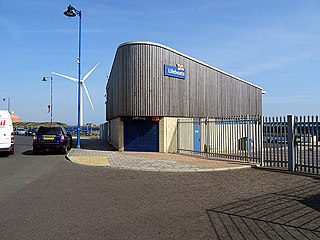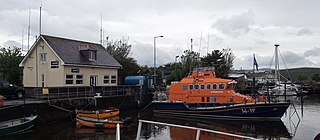History
The origins of a lifeboat at Seaton Carew are more set in rumour than fact. It is told that Quaker Thomas Backhouse, a banker from Backhouse's Bank, Darlington, was visiting the town, and witnessed the wreck of a fishing boat. All hands were lost, as a crowd watched on. On hearing a lifeboat would have saved the men, he promised a lifeboat for the town. [2]
Whatever the rumours, records show that a lifeboat was operational at Seaton Carew in 1824. According to the List of shipwrecks in October 1824, no fewer than 11 vessels were driven ashore at Seaton Carew on 11 October 1824. The Sophia of Rostock was wrecked on the North Gar off the mouth of the River Tees, with the loss of the Captain. The survivors were rescued by the Seaton Carew Lifeboat. [3]
No specific details of the lifeboat have been found. By 1825, the lifeboat was being managed by the Tees Bay Lifeboat and Shipwreck Society (TBLSS), which was founded in 1823. In 1847, Hartlepool Lifeboat Society took over the operations of the TBLSS, and in 1857, the responsibility of Seaton Carew lifeboat station was transferred to the RNLI. [2]
The RNLI carried out repairs and alterations to the boathouse, costing £57, and a new 30-foot Self-righting 'Pulling and Sailing' (P&S) lifeboat, one with oars and sails, was placed at Seaton Carew. Funded by a gift from William McKerrell of Bath, Somerset, the boat was named Charlotte. [1] [2]
The List of shipwrecks in February 1861 shows at least 18 vessels wrecked or driven ashore at Seaton Carew on 9 February, 1861. The Seaton Carew lifeboat Charlotte was first able to rescue eight from the brig Mayflower, wrecked on the East Gar Sands. Another eight were then rescued from the brig Providence, wrecked at Middleton, Hartlepool. [4]
November 1861 was a particularly busy month for the Seaton Carew lifeboat. On 1 November, five were rescued from the barque Robert Watson, on passage from Hamburg to Sunderland. On 2 November, she rescued the crew of the barque Rimouski of Russia. The crew of the sloop Welland, driven ashore en route to Newcastle-upon-Tyne, were rescued on 14 November. [5] [6] [7]
In a north east gale on 11 March 1883, the Norwegian schooner Atlas of Drammen, bound for Sunderland with a cargo of ice, had refused a tow by the Shields steam-tug, but had subsequently been blown into Hartlepool Bay. Taken in tow by the Hartlepool steam tug, the line had parted twice, and even with her anchor dropped, she was driven onto Longscar Rocks. The Seaton Carew lifeboat was called at 20:30, but couldn't find the vessel. Coxswain Henry Hood and crewman John Franklin climbed on the rocks. During their search, Hood was washed into the sea, but managed to climb ashore. On finding the wreck, they were joined by crewman Matthew Franklin. The mate of the Atlas was seen and pulled from the surf, and the four remaining crew were transferred to the rocks by line. In perilous conditions, with the sea washing over them, all eight made their way back to the waiting lifeboat. RNLI Silver Medals were awarded to Hood, and both John and Matthew Franklin. Coxswain Henry Hood was subsequently awarded the Albert Medal, Second Class (Bronze) by H.M. Queen Victoria. [8] [9] [10]
Just after 06:00 on 31 January 1907, the steamship Clavering of London stranded on the North Gare breakwater, just after leaving Middlesbrough. The Seaton Carew lifeboat Charles Ingleby (ON 131), on loan to the station from Hartlepool, launched and rescued 15. The Hartlepool No.1 lifeboat Ilminster (ON 242) was brought by road to Seaton Carew at 17:30, and a further attempt by both boats was made later that evening, but abandoned at 02:00. The remaining 24 survivors were rescued in daylight, all landed by 13:00 on 1 February. Coxswains of both lifeboats were awarded the RNLI Silver Medal, one being John Henry Franklin, now Coxswain Superintendent, who had been part of the 1883 rescue. [9] [11]
In 1922, Seaton Carew Lifeboat Station was closed. The lifeboat on station at the time, Francis Whitbourn (ON 576), was retained for demonstration use, finally being sold in 1934. The station building is long since demolished, but the four houses remain, as shown in the picture at the head of this page. [1]






















